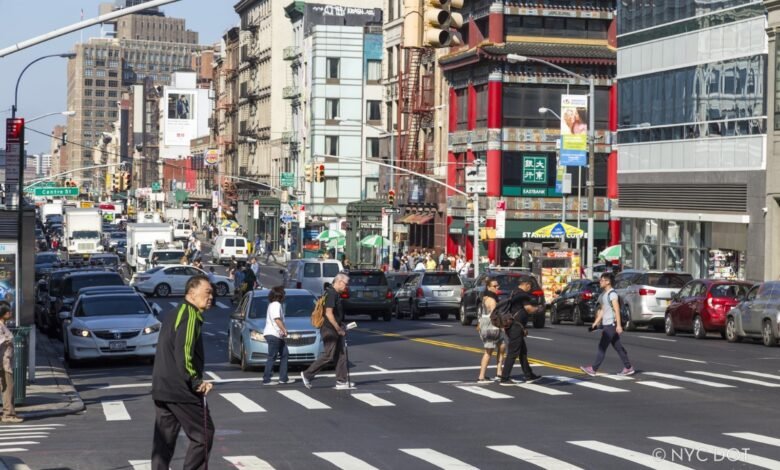NYC to install ‘super sidewalks’ and other pedestrian upgrades along Canal Street


All photos courtesy of NYC DOT
Canal Street will soon join the roster of major New York City corridors slated for major upgrades. The city’s Department of Transportation plans to redesign the Lower Manhattan thoroughfare from West Street to Bowery with “super sidewalks,” which widen the sidewalk across several blocks, a new protected bike lane, and more public space, according to the agency’s design proposal. The agency first revealed the project to local stakeholders in August and expects to complete it by next summer.

The project marks a long-overdue improvement to the corridor, where street vendors and heavy foot traffic often congest pedestrian space.
As first reported by Streetsblog, DOT will install “super sidewalks,” painted footpath extensions that also shorten crossings, on Canal between Broadway and Elizabeth Street, expanding pedestrian space and improving circulation.
At nearly 30 locations across the corridor, DOT will install new street crossings and shorten existing ones, including another sidewalk extension between Greenwich and Washington streets. The redesign calls for full block sidewalk extensions along Canal Street at 14 locations and concrete islands at Sixth Avenue and Mott Street to shorten crossing distance and better direct traffic flow.
DOT also plans to close the last block of Walker Street between Baxter and Mulberry Streets, enlarging the triangle with the Chinatown information kiosk, and eliminating a side street that funnels traffic from the Holland Tunnel.

A new two-way bike corridor will allow cyclists from the Manhattan Bridge to connect to Grand Street via the Bowery—which currently only offers an eastbound cycle path—and back to Canal between Sixth Avenue and Hudson Street before continuing onto Watts Street and the Hudson River.
To make room for the new path, the agency will remove an eastbound lane on the western stretch of Canal and relocate parking and loading from Canal and Grand Streets to nearby side streets.
The plan also links north-south bike lanes on Sixth Avenue, Hudson Street, and Varick Street—currently plagued by heavy traffic near the Holland Tunnel—and creates a more direct east–west route.

DOT has proposed adding more public space by closing Walker Street between Baxter and Canal Streets. The agency is also considering upgrades along Church Street, from Canal to Franklin Street, that would prioritize open space.
For decades, residents and businesses in Lower Manhattan have called for street safety improvements along Canal Street. While roughly two-thirds of people in the area travel on foot, cars currently take up about 90 percent of the street space.
A 2022 DOT survey found that nearly all visitors get to Canal Street by walking, public transit, or cycling. Only four percent of shoppers and three percent of restaurant-goers or other visitors use a car to reach the area.
In July, an intoxicated driver sped off the Manhattan Bridge at over 100 miles per hour in a stolen rental car, killing two people, while another motorist crashed into a food truck at the same location less than 24 hours later.
DOT has since installed jersey barriers and sand barrels in a buffer near the crash site, lowered the speed limit on the bridge from 35 mph to 20, and narrowed the existing lanes on the lower roadway, according to a DOT presentation to Manhattan Community Board 3.
William Fowler, a spokesperson for the Adams administration, told Streetsblog that the mayor is working to develop a new street design for Canal.
“The Adams administration is dedicated to ensuring every New Yorker can enjoy safe streets, and is working to make Canal Street’s future more than a high-crash, highway-like corridor that splits Lower Manhattan in two,” Fowler said.
He added: “We are working quickly to put forward a new street design that will protect everyone who shares this street, improve traffic flow, and address congestion on Canal Street’s sidewalks, as we continue to ensure the community has input in this process.”
Canal Street’s rework joins a growing list of city corridors slated for infrastructure improvements. Work begins this fall to bring center-running bus lanes and other upgrades to Brooklyn’s Flatbush Avenue. Other projects include upgrades to the Bronx’s Grand Concourse, Park Avenue, and Fifth Avenue.
DOT announced five in-person workshops for New Yorkers to share feedback on the proposal. An online survey is also available here.
The first workshop will take place on September 17 from 4 p.m. to 7 p.m. at Canal and 6th Avenue, followed by sessions on September 25 from 11 a.m. to 2 p.m. and September 27 from 12 to 3 p.m., both at Canal and Walker Street. The final workshop is scheduled for October 1 from 6 to 7:30 p.m. at P.S. 130 The De Soto School, located at 143 Baxter Street.
“Every New Yorker deserves safe streets, and that is why this proposal for Canal Street aims to turn a high-crash, highway-like corridor into a street that is safer for everyone,” DOT Commissioner Ydanis Rodriguez said.
“Through the planning process, we will gather important public feedback on how the future design of this street can improve safety for everyone, ease congestion, and increase economic growth. I encourage everyone to ensure their voices are heard through our upcoming workshops.”
RELATED:
Source link




